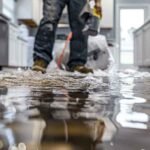Recognizing the Signs of Water Damage
To tackle water damage effectively, it’s essential to recognize the signs early. Here are some common indicators:
–Discoloration and Stains:One of the most visible signs of water damage is discoloration on walls and ceilings. Look for yellow, brown, or copper-colored stains, which are often indicative of water accumulation.
–Peeling or Bubbling Paint and Wallpaper:Excess moisture can cause paint and wallpaper to lose adhesion, leading to peeling or bubbling.
–Warped Flooring:Hardwood floors can warp and buckle when exposed to water. Carpets may feel damp and may develop an odor.
–Mold Growth:Mold thrives in damp environments. If you notice mold on walls, floors, or ceilings, it’s a clear indication of water damage.
–Musty Odors:A persistent musty smell often accompanies water damage, indicating the presence of mold or mildew.
–Increased Utility Bills:A sudden spike in your water bill could indicate a hidden leak.
Common Sources of Water Damage
Understanding where water damage typically originates can help in prevention and quicker identification. Common sources include:
–Leaking Pipes:Pipes can leak due to corrosion, high water pressure, or damage. Leaks often occur under sinks, in basements, or behind walls.
–Roof Leaks:Damaged or missing shingles can allow water to seep into your attic, leading to ceiling damage and mold growth.
–Appliance Malfunctions:Dishwashers, washing machines, and water heaters can leak due to faulty hoses or connections.
–Clogged Gutters:When gutters are clogged, water can overflow and seep into the foundation or walls of your home.
–Natural Disasters:Floods and heavy storms can lead to significant water damage, impacting the entire structure of the home.
Steps to Address Water Damage
Once you’ve identified water damage, it’s crucial to take immediate action to mitigate further issues.
1. Stop the Source of Water
The first step is to identify and stop the source of water. Turn off the main water supply if the damage is due to a plumbing issue. For roof leaks, temporarily cover the damaged area with a tarp until repairs can be made.
2. Remove Standing Water
Use a wet/dry vacuum or pumps to remove standing water. Quick removal is essential to prevent further damage and mold growth.
3. Dry and Dehumidify
After removing standing water, thoroughly dry the affected areas. Use fans, dehumidifiers, and open windows to increase air circulation and aid in drying. It’s important to address even hidden moisture to prevent mold growth.
4. Clean and Disinfect
Clean and disinfect all surfaces that have come into contact with water. This step is crucial in preventing mold and bacteria growth. Use appropriate cleaning solutions for different materials to avoid further damage.
5. Repair and Restore
Assess the extent of the damage and determine whether repairs are necessary. In cases of severe damage, such as structural issues or extensive mold growth, it may be wise to consult professionals for restoration. Water damage restoration companies can offer expertise and resources to restore your home effectively and safely.
Preventing Future Water Damage
Taking preventative measures can save you from future headaches and expenses.
–Regular Inspections:Regularly inspect your home for signs of leaks, especially after heavy rains or storms. Check roofs, gutters, plumbing, and appliances.
–Maintain Gutters and Downspouts:Ensure gutters and downspouts are clean and directing water away from your home’s foundation.
–Install a Sump Pump:In areas prone to flooding, a sump pump can help prevent water from accumulating in basements.
–Improve Home Ventilation:Proper ventilation in attics, basements, and crawl spaces can reduce humidity and prevent mold growth.
–Update Appliances and Fixtures:Replace old appliances and fixtures with newer, more reliable models to reduce the risk of leaks.
When to Call Professionals
While minor water damage can often be addressed by homeowners, there are situations where professional intervention is necessary. If the water damage is extensive, involves sewage, or if mold is present, it’s best to call in experts. They have the equipment and expertise to handle complex situations safely and effectively, ensuring your home is restored to its original condition.
In conclusion, water damage is a serious issue that requires prompt attention. By recognizing the signs and taking immediate action, you can mitigate damage and avoid costly repairs. Regular maintenance and inspections are key to preventing future issues, and when in doubt, don’t hesitate to contact water damage restoration companies for professional assistance. Acting quickly and efficiently can make all the difference in preserving the integrity and safety of your home.






Leave a Reply